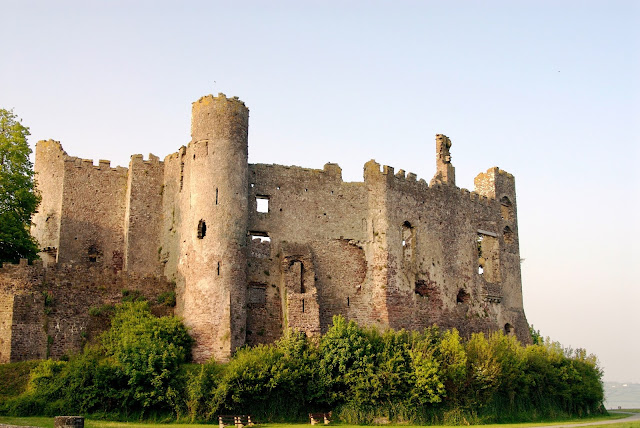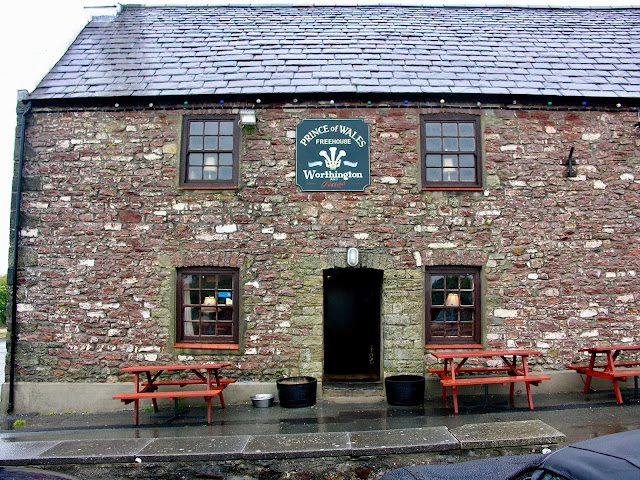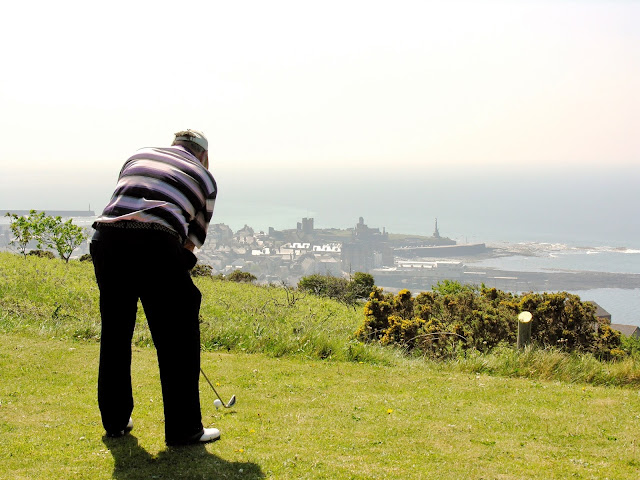 |
| Beaumaris Castle, Anglesey |
 |
| Carreg Cennen Castle, Llandielo, south Wales |
Three Special Pubs. Many of the pubs we visit (like coffee shops in the states) are local hangouts, and many have something special about them. Near Pwllheli GC we found two of these special pubs. The first was a modern gastro pub, where the food is more important than the drink, named Y Brycynan and owned by Dennis Moore who was also the Managing Secretary of Pwllheli GC.
The modern pub is a lively place which serves high quality meals for good prices--for example, scampi and fried potatoes, lamb shank. It’s a Must Stop in the area. Also interesting is the name which is old Welsh for…nobody seems to know. Dennis said it came with the pub and the former owners couldn’t translate it either. Tradition is important in Wales, so the name stayed the same.
The second special pub is the The Ty Coch Inn in the village of Porth Dinllaean which is the smallest official village in Wales and is located in the middle of Nefyn and District GC.
Take the path from the headland golf course, accessible from the twelfth or fifteenth tees, 100 yard down to the beach and the village which consists of a couple of houses and the Ty Coch Inn. After a drink or a meal, climb back up to the course and continue your round, A fantastic idea!
A third special pub on the trip was the Prince of Wales Inn on the outskirts of the village of Kenfig recommended to us by the golf pro at Pyle and Kenfig GC. After golf at P&K (as the locals call it), we dropped in to the Prince of Wales for quick pint (or in our case, a quick half). The pub’s stone exterior is very plain and the interior was fairly nondescript. What attracted our attention were the locals—living and dead. The pub dates back to the 15th century and has been a guild hall, courtroom, coroner’s inquest room, Sunday school room, and a mortuary for shipwrecked sailors. With this history it’s obvious why the inn is considered one of the most haunted in Britain. While we didn’t meet any of the local spirits (except the ones in our glass), we did observe an interesting local.
 |
| Our second visit to the Prince and the old guy is alone. |
The older gentleman was “holding court” with his chums when a young girl (probably a granddaughter) came in and told him it was time to go home to dinner. He told her he’d be along as soon as he finished his story. She said, “You’d better hurry, Mum is getting angry!” His buddies chuckled as the story ended abruptly and the man left. We liked the pub so much we went back the next night for dinner. The same local was sitting on the same stool, but he was alone. When his granddaughter came in to gather him for dinner, he immediately left with her. Even though we stayed longer and looked harder the second night we still saw no ghosts. I wouldn’t doubt though that many of the bar stools are occupied with the spirits of locals waiting to be called home.
 |
| Two views of Aberystwyth from the local golf course. |
No golf at Borth GC. It happened in Ireland at a course in Galway, and now it has happened in Wales. We arrived at Borth GC just south of Machynllth village along the west coast of Cardigan Bay just ahead of our scheduled tee time. The lady in the golf shop had us on the tee sheet, but said we owed for green fees. This is not unusual and we always keep a copy of our arrangements with the course manager. I told the lady we were writing about the course and golf was complimentary. She said, “Yes, but it doesn’t say free.” I asked her to talk to the secretary who had made the arrangements and she did. The secretary came out and said she hadn’t intended to give us free golf, but how about half price. At this point we walked out. It costs the club nothing to put two people out the course for a round, and if a course is up front about not giving us “courtesy of the course” we will often decide to pay and play anyway. I draw the line, though, when a course reneges on its promise. We spent our found time doing some great touring in Wales [see next story].
 |
| The Aberystwyth funicular tram to the overlook and golf course. |
Devil’s Bridge. The Devil’s Bridge is an interesting site we would have missed had not Borth GC turned us away. It’s where three bridges have been built, one over another, over a gorge.
We walked down to the bottom of the gorge and could view all three bridges stacked up (for a small fee). We then hiked back up to the top in time to see a steam train coming into the small station near the bridge. We later recognize the bridge in the mystery TV series Hinterland. We missed golf in Borth, but made good use of our extra time.
 |
| Laugharne Castle |
Two Boathouses of Laugharne. Besides the Laugharne Castle, the village hosts two Boathouses, both quite interesting. The first and most known Boathouse in Laugharne is the site of poet Dylan Thomas’ (1914-1953) writing shed overlooking the Taf estuary.
 |
| The coastal path with view of Dylan Thomas' Boathouse. |
 |
| Thomas' Writing Shed |
The boathouse is now a tearoom on the new Wales Coastal Path. The small writing shed, where Thomas did much of his later writing, is above the tearoom and has views of the estuary and part of the village. The wring shed is open for viewing most of the year.
The other Boat House in Laugharne is a high standard luxury B&B. The B&B has a Dylan Thomas connection as well. In his time the building was a pub, The Corporate Arms, where Thomas often drank. The B&B we booked into was run by mother/daughter duo,
Ann and Jenny. Outstanding rooms, lovely service, and delicious meals made it the best in the area. Now run by new owners (2017), the Boat House B&B has maintained its stellar reputation.
 |
| The path to Ogmore Castle and the castle. |
The Welsh National Botanic Gardens. There are some wonderfully special gardens in Scotland and England. The small two acre Branklyn Garden in the city of Perth in is one of our GoTo stops on every trip to Scotland. Just outside of Crieff in central Scotland is Drummond Castle and Gardens with one of the most impressive formal gardens in the UK. Acorn Bank Gardens near Penrith in northern England is renowned for its herbal gardens and fruit orchards. The garden has a lovely tearoom serving specialties straight from the garden, such as hot bed lettuce soup which was delicious. And on this trip we were lucky to hear about and visit the Welsh National Botanic Gardens in Llanartheny in southern Wales.
Only recently opened (May 2010), the gardens are made up of several great exhibits. The Walled Garden has several themed gardens including the Boulder Garden, the Apothecary Garden, the Welsh Native Garden, the Slate beds, and more. The outstanding feature of the entire garden is the world’s largest single-span great glasshouse, a dramatic facility as long as a football field and twice as wide.
Housed in the glasshouse is a series of Mediterranean gardens. Besides the outstanding flowers and plants exhibited, there is a British Bird of Prey Centre with daily flying displays. We spent a couple of hours wandering amongst the exhibits and certainly could have spent more time if local golf hadn’t gotten in the way.
 |
| At Caerphilly Castle, southeast Wales |
 |
| Views of Caerphilly Castle, Wales' Largest |
 |
| Sunset at Aberystwyth |







































